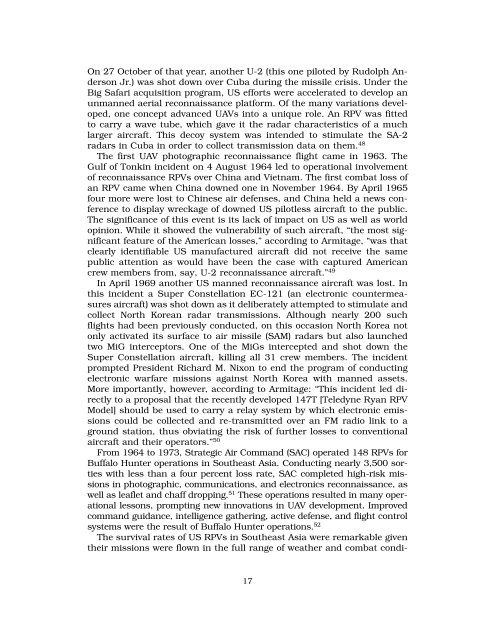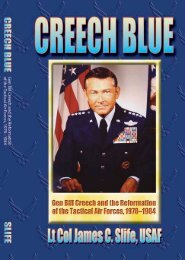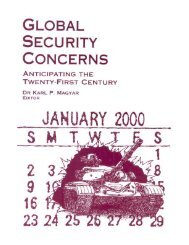Expendable Remotely Piloted Vehicles for Strategic Offensive ...
Expendable Remotely Piloted Vehicles for Strategic Offensive ...
Expendable Remotely Piloted Vehicles for Strategic Offensive ...
Create successful ePaper yourself
Turn your PDF publications into a flip-book with our unique Google optimized e-Paper software.
On 27 October of that year, another U-2 (this one piloted by Rudolph AndersonJr.) was shot down over Cuba during the missile crisis. Under theBig Safari acquisition program, US ef<strong>for</strong>ts were accelerated to develop anunmanned aerial reconnaissance plat<strong>for</strong>m. Of the many variations developed,one concept advanced UAVs into a unique role. An RPV was fittedto carry a wave tube, which gave it the radar characteristics of a muchlarger aircraft. This decoy system was intended to stimulate the SA-2radars in Cuba in order to collect transmission data on them. 48The first UAV photographic reconnaissance flight came in 1963. TheGulf of Tonkin incident on 4 August 1964 led to operational involvementof reconnaissance RPVs over China and Vietnam. The first combat loss ofan RPV came when China downed one in November 1964. By April 1965four more were lost to Chinese air defenses, and China held a news conferenceto display wreckage of downed US pilotless aircraft to the public.The significance of this event is its lack of impact on US as well as worldopinion. While it showed the vulnerability of such aircraft, “the most significantfeature of the American losses,” according to Armitage, “was thatclearly identifiable US manufactured aircraft did not receive the samepublic attention as would have been the case with captured Americancrew members from, say, U-2 reconnaissance aircraft.” 49In April 1969 another US manned reconnaissance aircraft was lost. Inthis incident a Super Constellation EC-121 (an electronic countermeasuresaircraft) was shot down as it deliberately attempted to stimulate andcollect North Korean radar transmissions. Although nearly 200 suchflights had been previously conducted, on this occasion North Korea notonly activated its surface to air missile (SAM) radars but also launchedtwo MiG interceptors. One of the MiGs intercepted and shot down theSuper Constellation aircraft, killing all 31 crew members. The incidentprompted President Richard M. Nixon to end the program of conductingelectronic warfare missions against North Korea with manned assets.More importantly, however, according to Armitage: “This incident led directlyto a proposal that the recently developed 147T [Teledyne Ryan RPVModel] should be used to carry a relay system by which electronic emissionscould be collected and re-transmitted over an FM radio link to aground station, thus obviating the risk of further losses to conventionalaircraft and their operators.” 50From 1964 to 1973, <strong>Strategic</strong> Air Command (SAC) operated 148 RPVs <strong>for</strong>Buffalo Hunter operations in Southeast Asia. Conducting nearly 3,500 sortieswith less than a four percent loss rate, SAC completed high-risk missionsin photographic, communications, and electronics reconnaissance, aswell as leaflet and chaff dropping. 51 These operations resulted in many operationallessons, prompting new innovations in UAV development. Improvedcommand guidance, intelligence gathering, active defense, and flight controlsystems were the result of Buffalo Hunter operations. 52The survival rates of US RPVs in Southeast Asia were remarkable giventheir missions were flown in the full range of weather and combat condi-17






